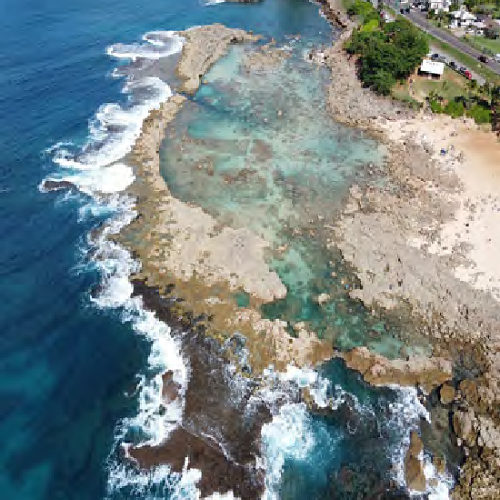By: MPW Staff
The area within the Pūpūkea Marine Life Conservation District (MLCD) that stretches from behind the Sunset Beach fire station over to the point between Shark’s Cove and Ke Iki is known as Kapo‘o. Kapo‘o gets its name from the loud echoing or booming sound of the waves that crash onto the exposed ancient reef, and as we move into our North Shore surf season it is the perfect time to listen and watch for these explosive displays.
Within Kapo‘o is a place of peace and safety; a sanctuary functioning much like a nursery: a pu‘uhonua for marine life. Many of us have experienced this protected place whether it was transiting by and seeing it; taking our keiki to play in its shallow waters; or perhaps you’ve taken the time to throw on a mask and snorkel to explore its shallow marine habitat. The Kapo‘o tide pool, commonly referred to as the Pūpūkea or Shark’s Cove tide pool, has served as an iconic landmark for those that live in the community or have spent time in the area.
The Kapo‘o tide pool area is unique from other coastal zone habitats found around Hawai‘i. It is a protective sub-tidal pool roughly the size of three football fields that maintains a connection to the ocean at several points; therefore, it is not, by definition, a tide pool. We on the North Shore have found comfort in calling it a tide pool, and though tide pools do occur at Kapo‘o, the feature most closely aligns with the description of a lagoon or coastal embayment. Either way, all three habitat types can function as an important nursery for reef fish and other marine life.
During months of little wave action, the tide pool takes on a brackish water nature when it is fed fresh water from submarine springs. The unique and dynamic ecosystem of the tide pool hosts an abundance of native juvenile fish species that help recharge fish stocks in the Pūpūkea Marine Life Conservation District. This in turn restocks fish in open fishing areas along the neighboring coastline outside of the MLCD in what is called spillover. Protecting fish and other marine species here means increasing numbers elsewhere.
Mālama Pūpūkea-Waimea (MPW) has performed years of kilo, or observations, in and around the Kapo‘o tide pool to capture changes in the natural environment which experiences heavy human use year-round. Kilo coupled with western scientific survey methods helps MPW understand the environment, ecology and the impacts to marine life in the Kapo‘o tide pool. Well over 80 unique species of fish, 30 species of limu (algae), and dozens of coral and invertebrate species make up the tide pool’s rich diversity of native marine life. Additionally, shorebirds, turtles, Hawaiian monk seals, eagle rays, and white-tip reef sharks often pay visits to the area.
The next time you’re in Pūpūkea (when the waves are flat), visit the Kapo‘o tide pool’s underwater classroom and enjoy its rich biodiversity and
abundance of marine life. For more information visit pupukeawaimea.org. You can also visit the Kapo‘o Story Map using this QR code. Mahalo!



